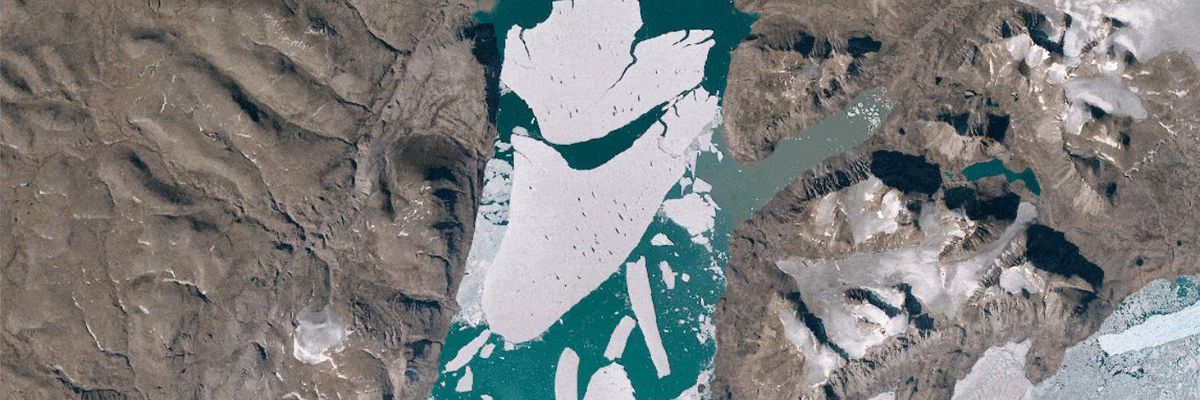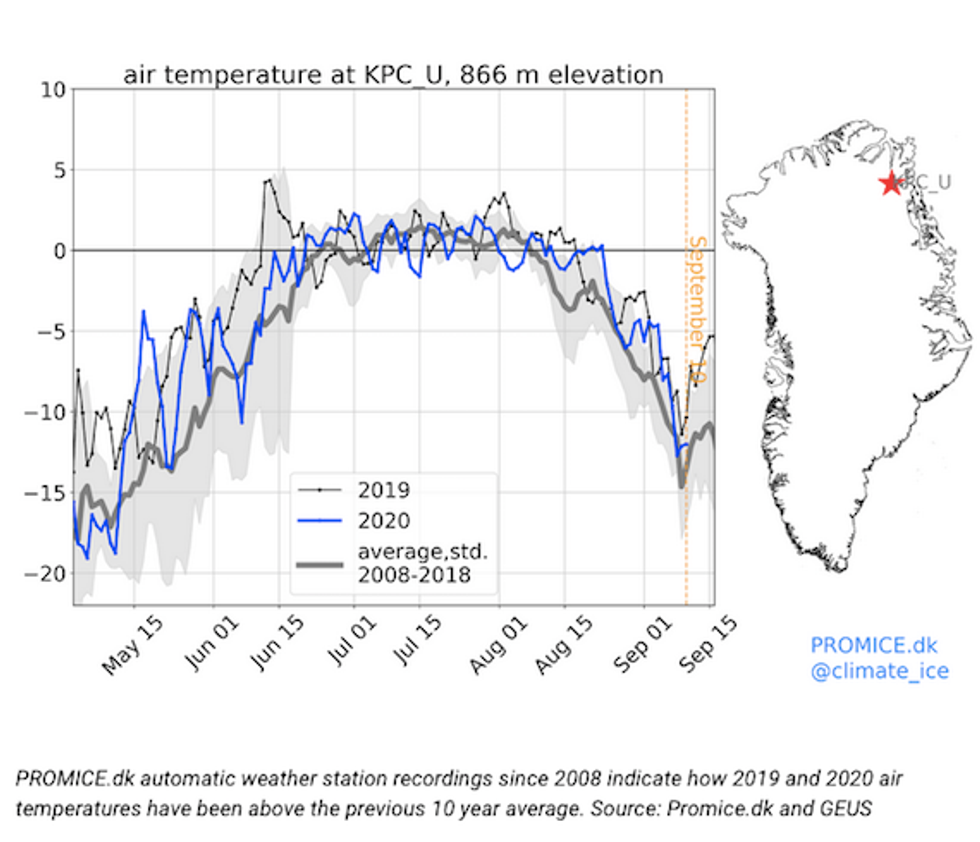
A Copernicus Sentinel-2 image captured on July 24, 2020 shows a segment of the largest ice shelf in the Arctic break up. (Photo: European Space Agency)
Arctic Heat Wave: Block of Ice Twice as Big as Manhattan Breaks off Greenland's Largest Ice Shelf, Goes Into Ocean
Rising temperatures are causing alarming glacier disintegration in the Arctic—and the Antarctic.
A 42 square mile block of ice has just hived off from the Arctic's largest ice shelf, in northeast Greenland, alarming climate scientists. That is the size of Santa Barbara, California. It is ginormous.
Danish scientists are speaking ominously of "glacier disintegration."
The Geological Survey of Denmark and Greenland reports,
"Annual end-of-melt-season area changes for the Arctic's largest ice shelf in Northeast Greenland are measured from optical satellite imagery, and it shows that the area losses for the past two years (year 2018/2019 and year 2019/2020) both exceeded 50 km2. In total, an area nearly twice that of Manhattan Island, New York. In the survey period since 1999, the ice shelf has lost 160 km2."
In the old days before human beings started burning so much coal, gasoline and natural gas, there were seasonal changes to the ice shelf. It would melt a bit in the summer but then grow back in the winter. Now it is just melting.
The Associated Press reports that last year, in 2019 alone, Greenland lost an unprecedented amount of ice, enough to cover all of California in over 4 feet of water. The average woman in the US is 5'5'' and the average man 5'10" so that would be up to their chests. The whole state.
The survey gives a graph where you can see how out of line 2020 has been with the average temperatures of the previous decade:
Average temperatures in Greenland have heated up by 5.4 degrees F. since 1980.
Speaking of the disintegration of glaciers, it is happening in Antarctica, too. There are two gargantuan glaciers, Pine Island and Thwaites, that are already responsible for 5% of sea level rise. They anchor the West Antarctic Ice Shelf. If they become unmoored, and the parts of the ice shelf that are not already in the water plop in to the ocean, it would raise sea level by an average of 10 feet over time.
That would pretty much do in Miami and New Orleans, but also parts of lower Manhattan. It would be a catastrophe.
So the bad news? They are becoming unmoored.
An Urgent Message From Our Co-Founder
Dear Common Dreams reader, The U.S. is on a fast track to authoritarianism like nothing I've ever seen. Meanwhile, corporate news outlets are utterly capitulating to Trump, twisting their coverage to avoid drawing his ire while lining up to stuff cash in his pockets. That's why I believe that Common Dreams is doing the best and most consequential reporting that we've ever done. Our small but mighty team is a progressive reporting powerhouse, covering the news every day that the corporate media never will. Our mission has always been simple: To inform. To inspire. And to ignite change for the common good. Now here's the key piece that I want all our readers to understand: None of this would be possible without your financial support. That's not just some fundraising cliche. It's the absolute and literal truth. We don't accept corporate advertising and never will. We don't have a paywall because we don't think people should be blocked from critical news based on their ability to pay. Everything we do is funded by the donations of readers like you. Will you donate now to help power the nonprofit, independent reporting of Common Dreams? Thank you for being a vital member of our community. Together, we can keep independent journalism alive when it’s needed most. - Craig Brown, Co-founder |
A 42 square mile block of ice has just hived off from the Arctic's largest ice shelf, in northeast Greenland, alarming climate scientists. That is the size of Santa Barbara, California. It is ginormous.
Danish scientists are speaking ominously of "glacier disintegration."
The Geological Survey of Denmark and Greenland reports,
"Annual end-of-melt-season area changes for the Arctic's largest ice shelf in Northeast Greenland are measured from optical satellite imagery, and it shows that the area losses for the past two years (year 2018/2019 and year 2019/2020) both exceeded 50 km2. In total, an area nearly twice that of Manhattan Island, New York. In the survey period since 1999, the ice shelf has lost 160 km2."
In the old days before human beings started burning so much coal, gasoline and natural gas, there were seasonal changes to the ice shelf. It would melt a bit in the summer but then grow back in the winter. Now it is just melting.
The Associated Press reports that last year, in 2019 alone, Greenland lost an unprecedented amount of ice, enough to cover all of California in over 4 feet of water. The average woman in the US is 5'5'' and the average man 5'10" so that would be up to their chests. The whole state.
The survey gives a graph where you can see how out of line 2020 has been with the average temperatures of the previous decade:
Average temperatures in Greenland have heated up by 5.4 degrees F. since 1980.
Speaking of the disintegration of glaciers, it is happening in Antarctica, too. There are two gargantuan glaciers, Pine Island and Thwaites, that are already responsible for 5% of sea level rise. They anchor the West Antarctic Ice Shelf. If they become unmoored, and the parts of the ice shelf that are not already in the water plop in to the ocean, it would raise sea level by an average of 10 feet over time.
That would pretty much do in Miami and New Orleans, but also parts of lower Manhattan. It would be a catastrophe.
So the bad news? They are becoming unmoored.
A 42 square mile block of ice has just hived off from the Arctic's largest ice shelf, in northeast Greenland, alarming climate scientists. That is the size of Santa Barbara, California. It is ginormous.
Danish scientists are speaking ominously of "glacier disintegration."
The Geological Survey of Denmark and Greenland reports,
"Annual end-of-melt-season area changes for the Arctic's largest ice shelf in Northeast Greenland are measured from optical satellite imagery, and it shows that the area losses for the past two years (year 2018/2019 and year 2019/2020) both exceeded 50 km2. In total, an area nearly twice that of Manhattan Island, New York. In the survey period since 1999, the ice shelf has lost 160 km2."
In the old days before human beings started burning so much coal, gasoline and natural gas, there were seasonal changes to the ice shelf. It would melt a bit in the summer but then grow back in the winter. Now it is just melting.
The Associated Press reports that last year, in 2019 alone, Greenland lost an unprecedented amount of ice, enough to cover all of California in over 4 feet of water. The average woman in the US is 5'5'' and the average man 5'10" so that would be up to their chests. The whole state.
The survey gives a graph where you can see how out of line 2020 has been with the average temperatures of the previous decade:
Average temperatures in Greenland have heated up by 5.4 degrees F. since 1980.
Speaking of the disintegration of glaciers, it is happening in Antarctica, too. There are two gargantuan glaciers, Pine Island and Thwaites, that are already responsible for 5% of sea level rise. They anchor the West Antarctic Ice Shelf. If they become unmoored, and the parts of the ice shelf that are not already in the water plop in to the ocean, it would raise sea level by an average of 10 feet over time.
That would pretty much do in Miami and New Orleans, but also parts of lower Manhattan. It would be a catastrophe.
So the bad news? They are becoming unmoored.


